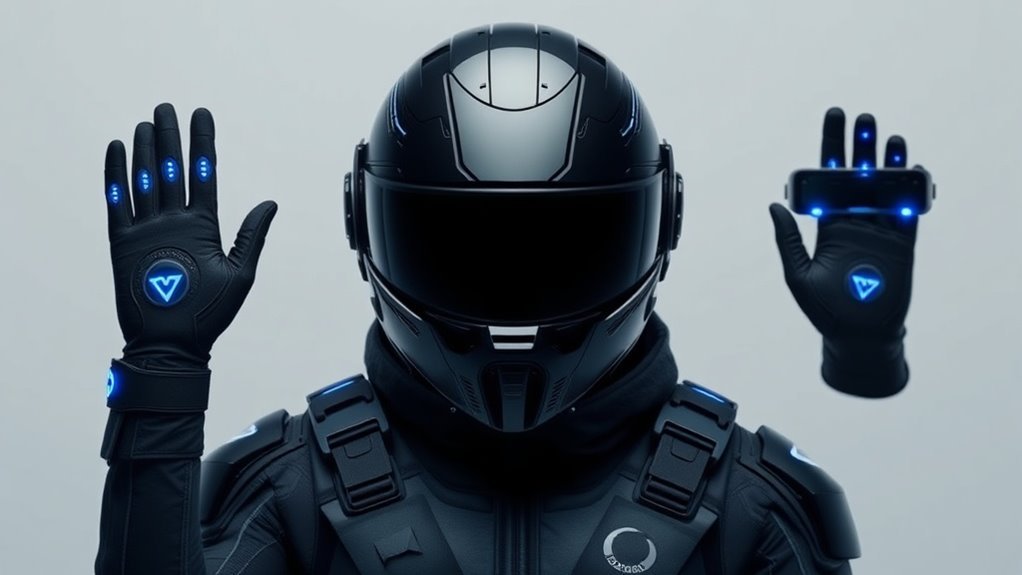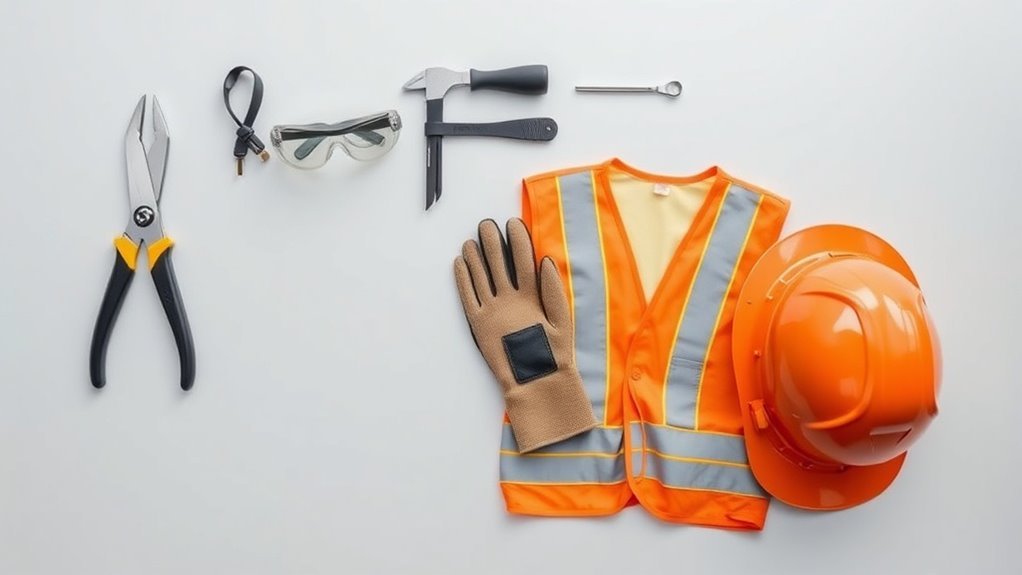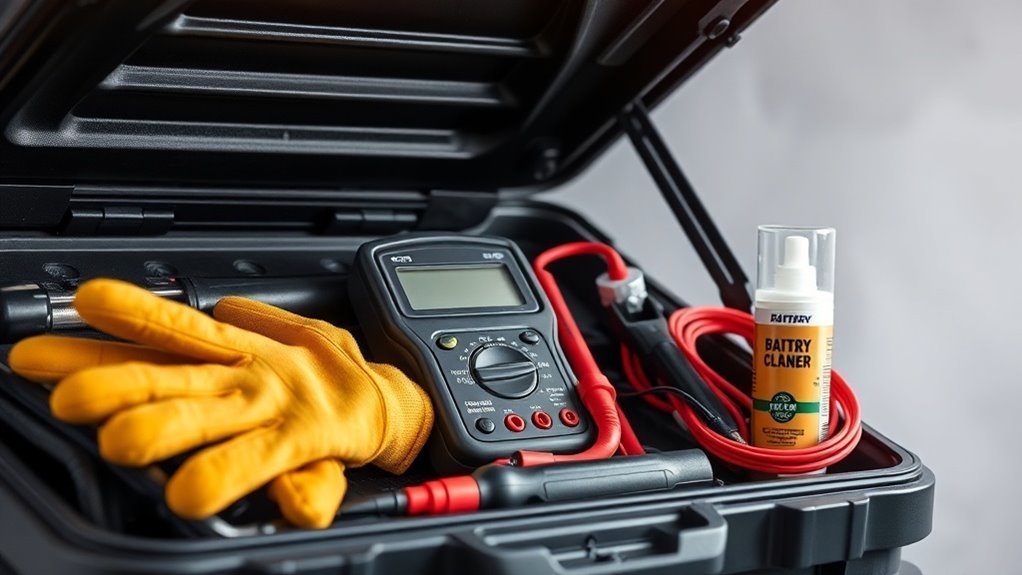Safety Goggles: Lens Types and Their Uses
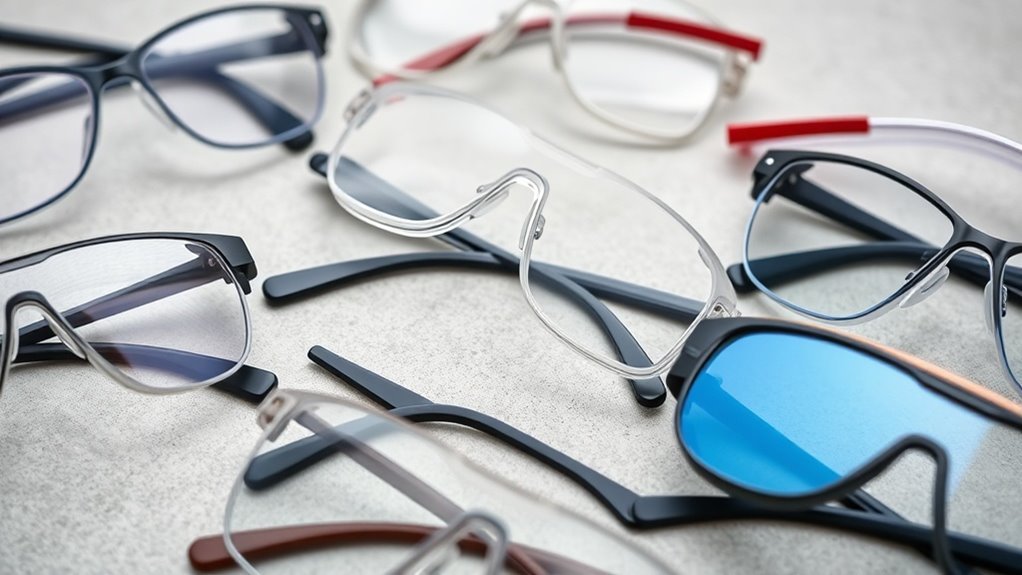
Safety goggles are essential to protect your eyes from various hazards. The lens types include polycarbonate for impact resistance, Trivex for optical clarity, and specialized options like tinted lenses to reduce glare. Anti-fog and scratch-resistant coatings enhance visibility and durability. If you require vision correction, options like single vision, bifocals, or progressives are available. Understanding these features helps you select the right goggles that fit your needs. There’s much more to discover about choosing the best safety goggles for your situation.
Key Takeaways
- Polycarbonate lenses are lightweight and impact-resistant, ideal for environments involving potential injury from flying objects or debris.
- Trivex lenses offer superior optical clarity, making them suitable for precision tasks where clear vision is essential.
- High-index lenses provide a thinner and lighter option for those who prefer a sleek design without compromising on safety.
- Tinted lenses reduce glare and provide UV protection, enhancing comfort in bright conditions while minimizing eye strain.
- Anti-fog coatings are crucial for humid environments, ensuring clear vision by preventing condensation on lenses during temperature changes.
Understanding Safety Goggles: An Overview
Safety goggles are vital protective eyewear designed to shield your eyes from hazards in various environments, whether you’re working in a lab, a construction site, or handling chemicals.
They’re specifically built to fit snugly around your eyes, preventing harmful particles, liquids, or gases from reaching them.
When choosing safety goggles, you should consider features like impact resistance, fog resistance, and how well they prevent dust and debris from entering.
It’s also vital to guarantee they comply with safety standards relevant to your industry.
The right pair not only helps protect your vision but also guarantees comfort and usability, so you can focus on your tasks without distraction.
Prioritizing eye safety is essential in any hazardous environment.
The Importance of Lens Coatings
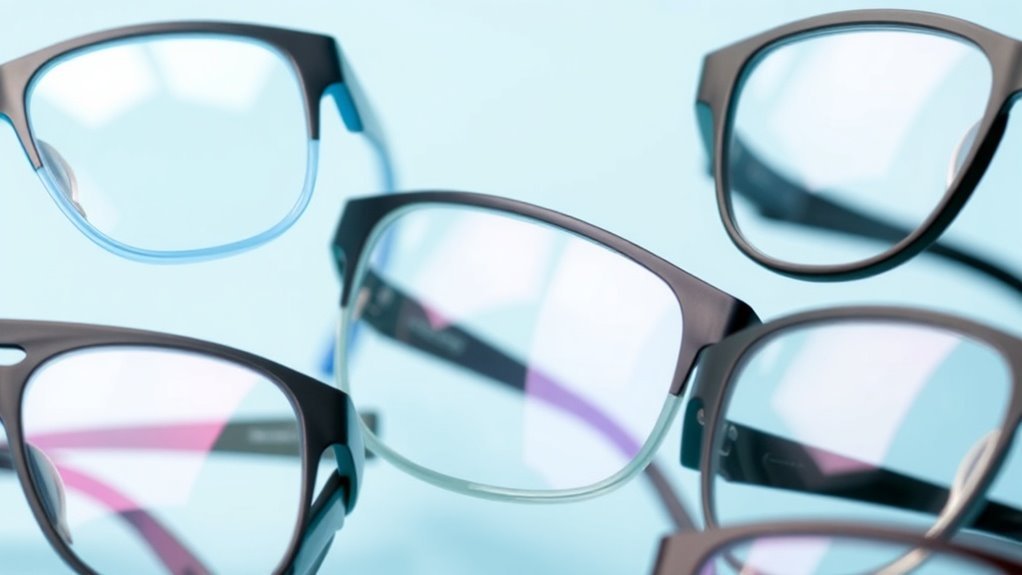
When choosing safety goggles, lens coatings can make a big difference in your protection and comfort.
Anti-fog, scratch resistance, and UV protection are just a few essential features that enhance your visibility and safety on the job.
Understanding these coatings can help you select the right pair for your needs.
Anti-Fog Coating Benefits
Although fogging can obscure your vision and hinder performance, anti-fog coatings on goggles provide a simple yet effective solution.
These coatings help maintain a clear view during activities where humidity or temperature changes are present.
Here are some key benefits:
- Safety: Enhanced visibility reduces the risk of accidents.
- Comfort: You’ll experience less frustration when your vision isn’t obstructed.
- Performance: Clear lenses allow you to focus on the task, improving overall efficiency.
- Durability: Anti-fog coatings can extend the lifespan of your goggles by preventing fog-related wear and tear.
With these advantages, investing in anti-fog coated goggles is a smart choice for anyone working in challenging environments.
Don’t let foggy lenses hold you back!
Scratch Resistance Features
Choosing the right goggles isn’t just about style; it’s also about ensuring durability, and scratch resistance is an essential feature to contemplate. When you work in environments where debris or chemicals are prevalent, having lenses that resist scratches can greatly prolong the life of your goggles.
Scratch-resistant coatings protect the lenses from everyday wear and tear, reducing distortion and improving visibility. You don’t want to constantly replace goggles due to scratches, which can be both costly and inconvenient.
Also, clear vision is paramount for safety, and scratched lenses can compromise that. Investing in goggles with high-quality scratch-resistant coatings makes your investment worthwhile and enhances safety during your work or recreational activities.
It’s a small feature that can make a massive difference.
UV Protection Importance
Scratches may affect your goggles’ clarity, but UV protection is just as vital for your overall eye safety. Without proper UV coatings, your eyes are vulnerable to harmful rays that can lead to serious issues.
Here’s why UV protection matters:
- Prevents Eye Damage: Long-term exposure can cause cataracts and other serious conditions.
- Increases Comfort: UV protection reduces glare, making it easier for you to see clearly in bright environments.
- Reduces Eye Strain: Protective lenses help minimize fatigue during prolonged use, especially outdoors.
- Enhances Visual Performance: Quality UV coatings improve color contrast, allowing better vision in varying light conditions.
Investing in safety goggles with proper UV protection is essential to keeping your eyes safe and comfortable.
Don’t overlook this important feature!
Anti-Fog Lenses: When Visibility Matters
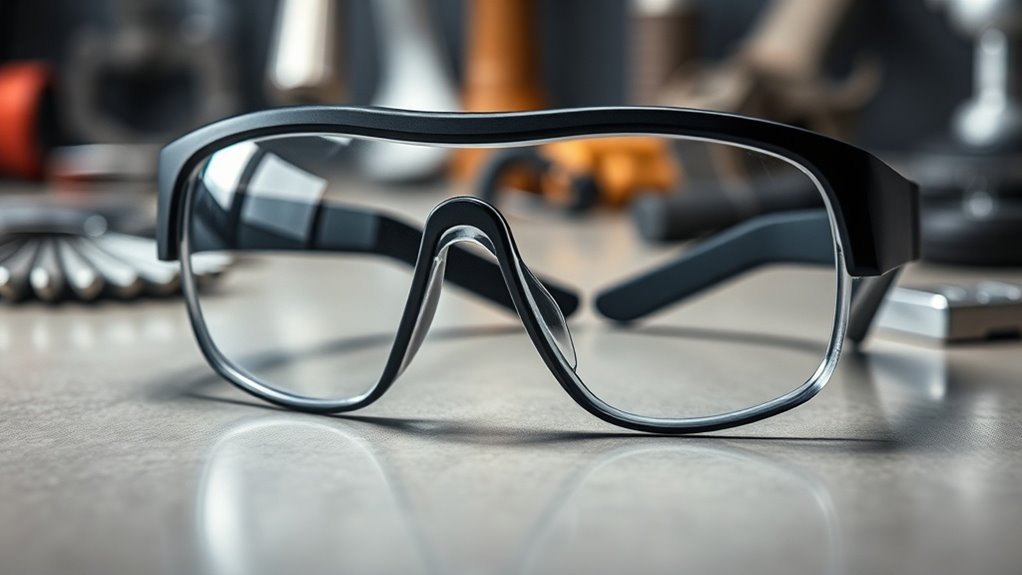
When you’re in situations where visibility is essential, anti-fog lenses can make all the difference. Whether you’re working in a humid environment, engaging in physical activity, or wearing a mask, fogging can obstruct your view and compromise safety.
These lenses are designed to minimize condensation, allowing you to see clearly without constantly needing to wipe them down.
Many anti-fog lenses use a special coating or treatment that prevents moisture buildup, ensuring your vision remains unobstructed. This feature is particularly beneficial in manufacturing, construction, or any task requiring precision.
Anti-Scratch Coatings: Durability and Longevity
Although safety goggles are essential for protection, their effectiveness can be undermined by scratches that impair vision. That’s where anti-scratch coatings come in, enhancing durability and prolonging the lifespan of your goggles. Here’s what you should know:
Safety goggles are crucial for protection, but scratches can hinder their effectiveness. Anti-scratch coatings enhance durability and lifespan.
- Material: Anti-scratch coatings are typically made from specialized polymers that increase impact resistance.
- Application: Applied to both polycarbonate and plastic lenses, these coatings help maintain clarity.
- Maintenance: While they resist scratches, proper cleaning techniques will extend their life, so avoid abrasive materials.
- Longevity: Even with coatings, the lifespan varies; some can last for years, safeguarding your vision stays clear for longer.
Prioritizing anti-scratch coatings guarantees your safety goggles remain effective, providing you with the best protection.
Tinted Lenses: Protection From Glare and UV Rays
Tinted lenses serve as an essential defense against glare and harmful UV rays, ensuring your eyes stay protected in bright environments.
Whether you’re working outside or in a brightly lit area, these lenses can considerably reduce eye strain and improve comfort.
You’ll find that various tints are available, each designed for specific conditions. For instance, gray lenses are great for general use, while yellow or amber tints enhance contrast in low light.
Furthermore, tinted lenses don’t just help with comfort; they also block a substantial amount of UV radiation, protecting your eyes from the long-term effects of sun exposure.
Prescription Lenses: Ensuring Clarity for Vision Impaired
When it comes to safety goggles for vision impaired individuals, choosing the right prescription lenses is essential.
You’ll want to explore various corrective lens options and compare different materials to guarantee both clarity and durability.
Plus, understanding the prescription verification process can help you get the right fit for your specific needs.
Corrective Lens Options
Corrective lenses play an essential role in ensuring that individuals with vision impairments can safely participate in activities requiring eye protection.
When choosing the right corrective lens options for your safety goggles, consider the following:
- Single Vision Lenses: Ideal for those needing prescription corrections for either distance or reading.
- Bifocal Lenses: Perfect if you require different prescriptions for distance and near vision, allowing for seamless shifts.
- Progressive Lenses: Offer a smooth gradient of prescriptions without visible lines, useful for various tasks.
- Anti-Fog Options: Essential for maintaining clear vision in humid environments or during physical activity.
Lens Materials Comparison
Choosing the right lens material for your prescription safety goggles can considerably impact your comfort and clarity of vision.
There are several options available to you, including polycarbonate, Trivex, and high-index lenses.
Polycarbonate lenses are lightweight and highly impact-resistant, making them ideal for safety applications.
Trivex lenses offer similar benefits but are often preferred for their superior optical clarity.
If you’re looking for a thinner and lighter option, high-index lenses might be your best choice.
Each material has its pros and cons, so consider your specific needs.
For instance, if you prioritize safety and durability, polycarbonate is an excellent pick.
If clarity is essential, Trivex might be more suitable.
Taking the time to choose wisely will enhance your overall wearing experience.
Prescription Verification Process
Before you can confidently wear your prescription safety goggles, it’s essential to verify your prescription to guarantee ideal clarity and comfort.
Confirming your lenses are tailored to your vision needs involves a few simple steps:
- Check Your Prescription: Make sure it’s up-to-date, and obtain a copy from your eye care professional.
- Confirm Lens Type: Discuss which lens type suits your work environment, whether it’s polycarbonate for impact-resistance or other options.
- Dispensing Details: Provide the necessary measurements, like pupillary distance, to confirm proper alignment with your eyes.
- Special Features: Decide if you need additional features, like anti-fog or anti-scratch coatings, for a comfortable experience.
Follow these steps to confirm your safety goggles will provide the clarity and protection you need.
Specialized Lenses for Unique Environments
When working in specialized environments, having the right lenses can make all the difference. Specialized lenses offer protection tailored for your surroundings, whether it’s glare reduction for welding or UV protection for outdoor activities. Here’s a quick overview of some options:
| Environment | Lens Type | Key Benefits |
|---|---|---|
| Welding | Darkened lenses | Reduces bright light |
| Chemical handling | Anti-fog | Prevents fogging |
| Outdoor work | Polarized | Reduces glare from sun |
| Laboratory | Scratch-resistant | Maximizes durability |
Choosing the appropriate lens for your specific work conditions safeguards not just your eyesight, but also enhances overall performance and comfort. Always verify you’re equipped with the best lenses for your unique challenges.
Selecting the Right Safety Goggles for Your Needs
Here are some key factors to evaluate when choosing the right pair:
- Lens Type: Decide between clear, tinted, or anti-fog lenses depending on your work environment.
- Fit: Confirm the goggles fit snugly without discomfort. Adjustable straps can help with this.
- Ventilation: Look for goggles with vents to reduce fogging while still providing protection from debris.
- Compliance: Check for compliance with relevant safety standards to guarantee adequate protection in your specific industry.
Additionally, consider using safety goggles in conjunction with effective respiratory protection to ensure comprehensive safety while working on DIY projects.
Questions
How Should I Properly Clean My Safety Goggles?
To clean your safety goggles, gently rinse them with warm, soapy water. Use a microfiber cloth to wipe the lenses, avoiding harsh chemicals. Rinse again with water and dry them thoroughly before storage.
Can Safety Goggles Be Worn Over Regular Glasses?
Yes, safety goggles can be worn over regular glasses. For example, if you’re welding, using goggles can protect your eyes from sparks while allowing you to maintain your vision through your usual prescription lenses.
What Is the Lifespan of Safety Goggles?
The lifespan of safety goggles typically ranges from one to three years, depending on usage and care. It’s important you inspect them regularly for scratches or damage, replacing them when necessary to guarantee maximum protection.
Are There Safety Goggles Suitable for Children?
Sure, there’re safety goggles made just for kids, like a knight’s armor protecting a young hero. These goggles fit snugly, ensuring safety while they explore their world. Always check for proper sizing and comfort!
How Do I Know if My Goggles Fit Properly?
To guarantee your goggles fit properly, they should sit snugly against your face without pinching or pressure. Check for gaps, adjust straps for comfort, and make sure they don’t slip during movement.
Conclusion
In your quest for safety, choosing the right goggles is like finding the perfect armor for your eyes. Picture yourself confidently maneuvering through dust and glare, each lens tailored to your needs, like a knight in shining gear. With anti-fog and anti-scratch coatings guarding against obstacles, you can focus on the task ahead. So, whether it’s a bright construction site or a delicate lab, equip yourself with the ideal goggles, ensuring every vision is crystal clear and protected.

